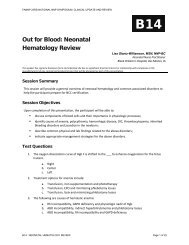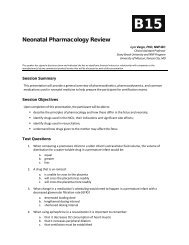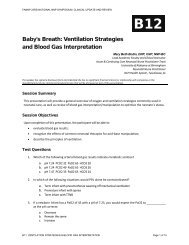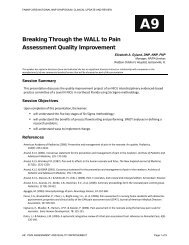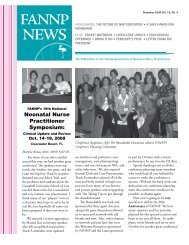Differential Diagnosis and Management of Respiratory ... - FANNP
Differential Diagnosis and Management of Respiratory ... - FANNP
Differential Diagnosis and Management of Respiratory ... - FANNP
You also want an ePaper? Increase the reach of your titles
YUMPU automatically turns print PDFs into web optimized ePapers that Google loves.
<strong>FANNP</strong> 23RD NATIONAL NNP SYMPOSIUM: CLINICAL UPDATE AND REVIEW<br />
Mechanical Ventilation<br />
Conventional Mechanical<br />
Ventilation<br />
• The primary goal is to maintain normal FRC while<br />
avoiding over-expansion. Adequate <strong>and</strong> stable<br />
oxygenation is maintained using the lowest MAP.<br />
• Over-expansion can elevate PVR <strong>and</strong> increase R to<br />
L shunting.<br />
• Strategy is determined by underlying pathology.<br />
• Conventional ventilation has been successful in many<br />
institutions using guidelines for PaO2 50 - 70 <strong>and</strong><br />
accepting PaCO2 up to 60. *Aiming for higher PaO2<br />
may require increased ventilator support <strong>and</strong><br />
barotrauma.<br />
• Avoid hyperventilation by correcting pH with<br />
buffers.<br />
• Lowest possible MAP with lowest possible positive<br />
end-expiratory pressures.<br />
109<br />
110<br />
ECMO<br />
OI Calculation<br />
• Each ECMO center will establish specific inclusion<br />
criteria.<br />
• Generally accepted: ANY <strong>of</strong> the following AND<br />
underlying disease process which is likely to be<br />
reversible.<br />
• St<strong>and</strong>ard: OI > 40 on conventional ventilation or ><br />
50 - 60 on HFOV. (0.5 - 6 hours)<br />
• PaO2 < 40 mm Hg for >2 hours despite maximum<br />
ventilatory support.<br />
• Acidosis <strong>and</strong> Shock (pH < 7.25 due to metabolic<br />
acidosis, lactate build-up, intractable hypotension)<br />
• OI = FiO2 X MAP X 100 / PaO2 (mm Hg)<br />
• 1.0 X 18 X 100 / 40 = 45<br />
• Oxygen Index calculators available online. One example:<br />
• http://www.adhb.net.nz/newborn/Guidelines/<strong>Respiratory</strong>/<br />
<strong>Respiratory</strong>IndicesCalculator.htm<br />
111<br />
112<br />
Congenital<br />
Diaphragmatic Hernia:<br />
(CDH)<br />
• Occurs at a frequency <strong>of</strong> 1 in<br />
2500 live births.<br />
• Most common on the left.<br />
• Accompanied by ipsilateral<br />
pulmonary hypoplasia.<br />
• Severe respiratory distress<br />
at birth.<br />
• Usually has a scaphoid<br />
abdomen.<br />
Congenital Diaphragmatic Hernia:<br />
(CDH)<br />
• If prenatally diagnosed, endotracheal intubation <strong>and</strong><br />
mechanical ventilation with rapid rate <strong>and</strong> low inflation<br />
pressures. Tolerate hypercapnia to a degree.<br />
• Most likely have or will develop PPHN.<br />
• Survival is poor in infants who are very symptomatic at<br />
birth. ECMO is <strong>of</strong>ten required to no avail.<br />
• Controversy among surgeons as to urgency <strong>of</strong> surgical<br />
repair.<br />
• Stabilization is by mechanical ventilation, vasopressors,<br />
correction <strong>of</strong> acidosis prior to surgery. Some perform<br />
surgical repair while the infant is under ECMO.<br />
113<br />
114<br />
B07: MANAGEMENT OF RESPIRATORY DISTRESS Page 21 <strong>of</strong> 23



